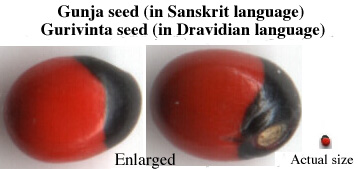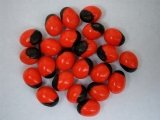Rattee
Rattee is known
by many names - Goonjaa Seeds or Gunjaa Phal (in Sanskrit), Gurivintaa seed
(in Dravidian language), or Chirmee seeds, Chanotee (in Gujaraat) etc.
Chirmee seeds are found in the forests of Araavalee Hills, Rajasthaan
and so many other areas .They symbolize Goddess Lakshmee and it is said
that the wearer is blessed with wealth, prosperity and harmony. It is
commonly said that the beads select their owner and will never stay with
an unlucky person. These seeds are used to ward off evil, bring good
luck and ward off physical harm. These are considered very powerful in
Hinduism.
These
naturally grown beads are found in forest of Araavalee mountains, India
and are believed to be many hundred years old. It is said that the bead
itself will choose its owner and will not stay with an unlucky person.
Since the goddess of wealth, Lakshmee, stays near to these beads they
should be kept in lockers, money safe, cash box, altar, handbag, and
purse. You can also keep these beads in pocket also to get same effect.
They bring luck and ward off evil and black magic, and protect the
wearer from physical harm by taking the abuse upon themselves.
Properly
energized bead can create good miracle. These seeds/beads are used in so
many other Taantrik practices. Apsaraa Saadhanaa, Durgaa Saadhanaa,
Vasheekaran Saadhanaa can be followed with these beads. There are
several varieties of Chirmee seeds like white/black; green/red-black.
Whereas black, white and green are considered very auspicious.
Rattee and Astrology
Astrologically and by Lal Kitab too, a Rattee white in color with a dull
red spot, or a dull red Rattee with a white spot alone can be taken as
auspicious because then it would signify Moon + Shubh Mars = Shreshth
Dhan. Dull and non-shining red represents Benefic mars whereas the bright
and shining red signifies Malefic Mars. If such Rattee are available, then
keep them tied in a yellow cloth in your Tijoree / where you keep your money.
No rituals necessary before keeping them. One can keep 4 of them in the North
East corner of his house. But make sure that the person should not have
Mercury or Saturn in the 4th or 10th house of in his Birth chart.
There are so
many usages of white Chanotee. White Chanotee is very rare. It is found
in our GEER forest.
If we keep the white Chanotee after make it Siddh with chants and herbs
in red cloth in place where we keep money it gives more wealth. Chant
should be recited according to the person's birth sign and horoscope
then it gives amazing result in wealth.
Difference between "Rattee" the old Indian measure unit for gems and
the modern day metric unit of "Gram"?

Paanini, Sanskrit grammarian
(c500 BC) in his treatise Ashtaadhyaayee wrote about coins and various
fractions suggesting that the concept of coins existed prior to 500 BCE.
He mentioned Shatamanas (shata= 100, manas = units) and Karshapana (sub-fraction).
Each unit was called "Rattee" weighing 0.11 grams. Rattee was
of average weight of a Gunja seed (a bright red seed with a black tip -
see the picture below).

What is Gunja Seed?
 A
high-climbing, twining, or trailing woody vine with alternately compound
leaves, indigenous to India. Leaves alternate, 5-13 cm long, even-pinnately
compound with 5-15 pairs of leaflets, these oval to oblong, to 1.8 cm
long, with margins entire.
A
high-climbing, twining, or trailing woody vine with alternately compound
leaves, indigenous to India. Leaves alternate, 5-13 cm long, even-pinnately
compound with 5-15 pairs of leaflets, these oval to oblong, to 1.8 cm
long, with margins entire.
The flowers, shaped like pea
flowers, are small, pale, violet to pink and arranged in clusters. Its fruit
is a short, oblong pod, splitting before falling to reveal 3-8 shiny hard
seeds, 6-7 mm long, scarlet with black bases. The seeds of abrus precatorius
are much valued in native jewelry for their bright coloration. One third of
the bean with the hilum (attachment scar) is black, while the rest is bright
red, suggesting a ladybug.
Jewelry-making with
jequirity seeds is dangerous, and there have been cases of death by a finger-prick
while boring the seeds for beadwork. The seeds were traditionally used to weigh
jewelry in India. The measure rattee रत्ती is equal to
the weight of one seed.
Thus Rattee is a
traditional Indian unit of mass measurement, and has now been standardized
as
1 Rattee = 0.12125 gram
8 Ratti or 0.97 gram = 1 Maashaa
12 Maashaa or 11.67 gram = 1 Tolaa
Gunja Seed:
<>Common name:
Coral bead vine, Rosary pea, गुंची
Gunchi (Hindi), गुंजा Gunjaa
(Sanskrit), गुलगुंजी
Gulugunji (Kannada), गुंच Gunch (Bengali),
Ratti रत्ती (Gujarati), குந்து மணி
kundu maNi (Tamil), गुंज Gunja (Marathi)
Botanical name: Abrus precatorius Family:
Fabaceae (pea family) |
From another Indian scripture,
Old Indian Measures <=> Metric Measures
|
1 Maasha |
= |
8 Rattee |
= |
1 gram |
= |
5 Carats |
|
1 Tolaa |
= |
12 Maashaa |
= |
12 Grams |
|
|
|
1 Chhataank |
= |
5 Tolaa |
= |
60 Grams |
|
|
|
1 Paav |
= |
4 Chhataank |
= |
250 Grams |
|
|
|
1 Ser |
= |
4 Paav |
= |
1 Kilogram |
|
|
Some useful links on Chirmee / Gunjaa seeds....
http://en.wikipedia.org/wiki/Abrus_precatorius
http://www.salagram.net/sstp-Gunja-malas.html#Danger
http://www.salagram.net/sstp-Gunja-malas.html
http://www.vedicstore.com/ratti.html
http://www.incredibleayurveda.com/herbs.aspx?id=30
http://www.botanicalbeads.com/BBB_page_50.html


 A
high-climbing, twining, or trailing woody vine with alternately compound
leaves, indigenous to India. Leaves alternate, 5-13 cm long, even-pinnately
compound with 5-15 pairs of leaflets, these oval to oblong, to 1.8 cm
long, with margins entire.
A
high-climbing, twining, or trailing woody vine with alternately compound
leaves, indigenous to India. Leaves alternate, 5-13 cm long, even-pinnately
compound with 5-15 pairs of leaflets, these oval to oblong, to 1.8 cm
long, with margins entire.